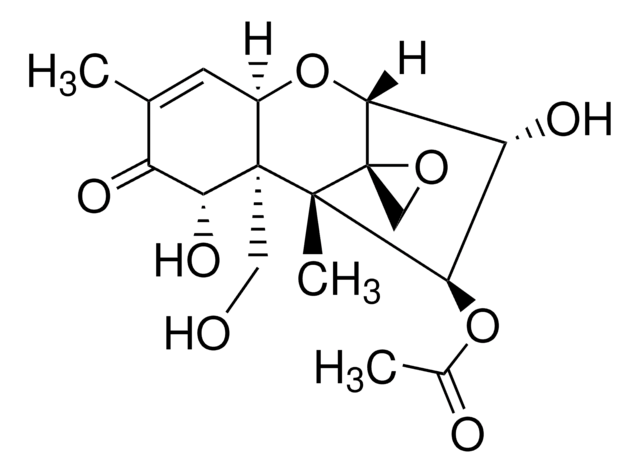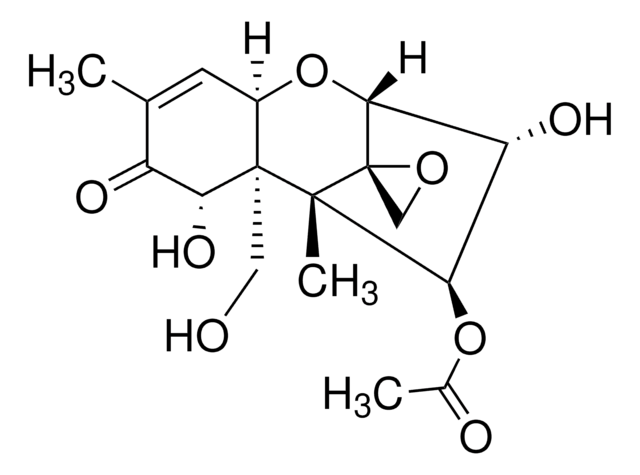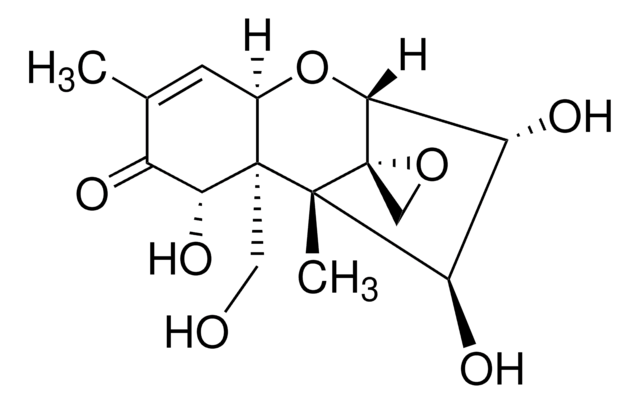32932
Neosolaniol
Synonym(s):
Neosolaniol from Fusarium sp., 4β,15-Diacetoxy-3α,8α-dihydroxy-12,13-epoxytrichothec-9-ene, 8-Hydroxydiacetoxyscirpenol, NEO
About This Item
Recommended Products
grade
analytical standard
reference material
shelf life
limited shelf life, expiry date on the label
manufacturer/tradename
Manufactured by: Sigma-Aldrich Production GmbH, Switzerland
technique(s)
HPLC: suitable
gas chromatography (GC): suitable
application(s)
agriculture
cleaning products
cosmetics
food and beverages
personal care
format
neat
storage temp.
−20°C
SMILES string
CC(=O)OC[C@]12C[C@H](O)C(C)=C[C@H]1O[C@@H]3[C@H](O)[C@@H](OC(C)=O)[C@@]2(C)[C@]34CO4
InChI
1S/C19H26O8/c1-9-5-13-18(6-12(9)22,7-24-10(2)20)17(4)15(26-11(3)21)14(23)16(27-13)19(17)8-25-19/h5,12-16,22-23H,6-8H2,1-4H3/t12-,13+,14+,15+,16+,17+,18+,19-/m0/s1
InChI key
TVZHDVCTOCZDNE-WVJYZQHISA-N
Looking for similar products? Visit Product Comparison Guide
General description
Application
- Wheat samples by acetonitrile-based extraction and gas chromatography-tandem mass spectrometry (GC-MS/MS) as well as capillary GC with flame ionization detection (FID).
- Cereals by acetonitrile-based extraction and GC coupled to mass spectrometry (MS).
Signal Word
Danger
Hazard Statements
Precautionary Statements
Hazard Classifications
Acute Tox. 1 Inhalation - Acute Tox. 2 Dermal - Acute Tox. 2 Oral
Storage Class Code
6.1A - Combustible acute toxic Cat. 1 and 2 / very toxic hazardous materials
WGK
WGK 3
Flash Point(F)
Not applicable
Flash Point(C)
Not applicable
Personal Protective Equipment
Choose from one of the most recent versions:
Already Own This Product?
Find documentation for the products that you have recently purchased in the Document Library.
Our team of scientists has experience in all areas of research including Life Science, Material Science, Chemical Synthesis, Chromatography, Analytical and many others.
Contact Technical Service








